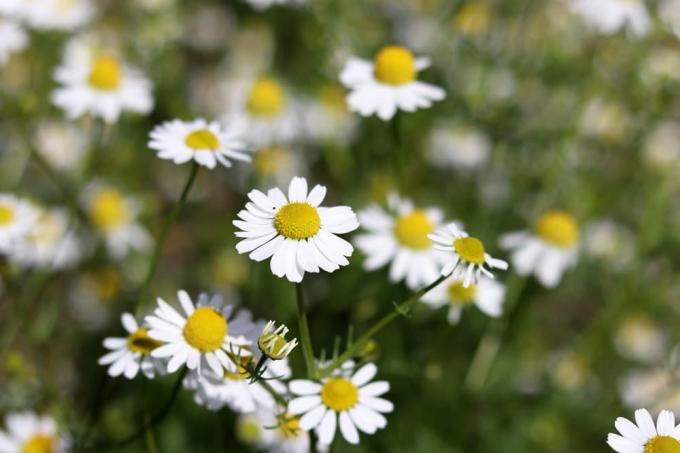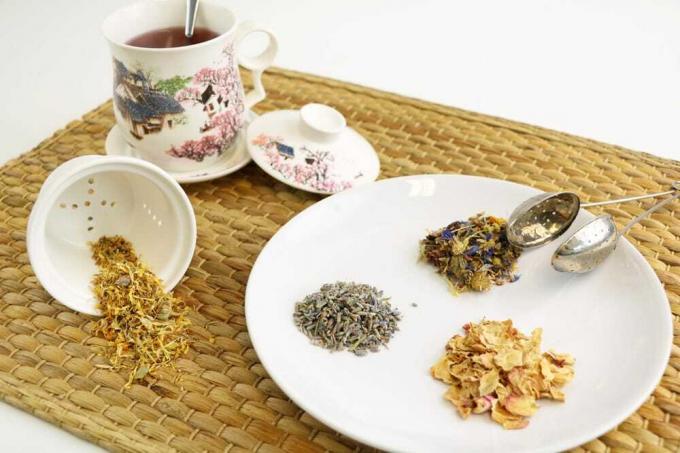

Table of contents
- Which herbs are suitable for tea?
- When is the best time to collect herbs?
- Where can I find tea herbs?
- How should I collect tea herbs?
- How are herbs dried?
- Out in the air
- In the flat
- In the oven
- In the dehydrator
- How are dried tea herbs stored?
As a home remedy, herbal tea is very popular for many everyday complaints and mood disorders. Such a tea not only relieves abdominal pain or colds, it also tastes very good and is inexpensive. If you collect and dry the plants yourself, you also avoid unnecessary transport routes and packaging waste. So there are many reasons to make a cup of tea again.
Which herbs are suitable for tea?
Walk along a supermarket shelf with herbal teas and you will see how diverse herbal teas are. In addition to classic medicinal herbs, there are many types of flowers and leaves from various trees and shrubs, but also some "weeds". Some of them have a very strong taste, these herbs should be used sparingly in mixtures. Other parts of the plant taste subtle and have a lot of mass. You can use these as fillers.
Tip:
Sensitive people should possibly be tested for allergies before collecting tea herbs.
Popular tea herbs:
- birch leaves
- nettle
- blackberry leaves
- strawberry leaves
- Verbena
- daisy
- Groundman
- raspberry leaves
- elderflower
- Johannis herbs
- chamomile
- Linden Blossoms
- dandelion
- lemon balm
- mint
- marigold
- yarrow
- buckhorn
Tip:
Many plants have inedible or even poisonous doubles. Therefore, only harvest plants that you know really well. Dried tea herbs are difficult to identify later.
When is the best time to collect herbs?
Most of the classic tea herbs should be collected shortly before the flowers begin, which more or less limits the harvest time. The ideal time is therefore often in the spring. Plants that bloom from spring to autumn, such as stinging nettles or marigolds, can be harvested almost all summer long.

Aside from flowering time, there are other points to consider when picking herbs. It is best to harvest on a dry day in the late morning. The dew should already have dried and the last downpour should have passed a few days. Then the plants have stored less water and the aroma is more intense. This also reduces the drying time.
Where can I find tea herbs?
Even without a planned herb cultivation, you can collect many tea herbs in your own garden. Plantain, daisies and ground ivy often settle by themselves, as do yarrow, dandelion or stinging nettles. Walk through your garden with open eyes and maybe armed with a herbal book and you will be amazed at the tea herbs you find there. However, plants for herbal tea should not be chemically fertilized or heavily stressed, as is often the case with a lawn, for example.
Looking for herbs in nature is also a lot of fun. However, you should exercise some caution here. The level of pollution on busy roads is now well known. Also, do not harvest crops on the edges of conventionally tended fields. Pesticides or fertilizers could have been used on the fields and spread around by wind and rain.
When harvesting berries and tea herbs in the forest, people are often warned about the eggs of the fox tapeworm. While the risk of infection may be small, you shouldn't ignore it entirely. Temperatures above 70°C will kill the eggs but are not recommended for treating herbs that are to be dried.
Tip:
Children often taste herbal tea much better if they have collected and dried the ingredients themselves.
How should I collect tea herbs?
When harvesting tea herbs, be careful not to uproot the plant, cut off too much of an herb, or otherwise damage the plant. This will ensure the continued existence of the plant and you can harvest again later in the same place. Do not transport your herb harvest in a plastic bag, the plants sweat in it and spoil easily. A basket is perfect, in it your collected goods have a lot of space and air. Also, only harvest absolutely healthy and undamaged parts of the plant.
Tip:
If you only ever harvest part of the plants that you have found in nature, you are contributing to the preservation of the species.
How are herbs dried?
In order for the plants you have collected to dry out quickly, you should avoid using water as far as possible. Only flush briefly if it is really necessary. Subsequent blotting dry is essential. You can chop up your tea herbs before drying, or you can dry them whole and rub them between your fingers later to separate the leaves from the stems. Which drying method you choose depends on local conditions, your preferences and the weather.
Tip:
Dry and store your herbs individually and mix them individually if you want to prepare a tea.
Out in the air

If drying outside, then dry weather is necessary. There is a risk of mold if the humidity is high. Light wind is ideal, it speeds up the drying process. Full sun, on the other hand, is not recommended, as the plants to be dried burn easily, the valuable ingredients are lost and the aroma diminishes. Tie small bouquets and hang them in an airy, warm and shady place. Your tea herbs should be dry after a few days.
In the flat
The kitchen is generally unsuitable for drying herbs. The humidity is usually higher than in other rooms. In addition, the dry season is often longer than outside. Make sure the drying room is adequately ventilated and regularly check the drying material for moisture. Daily turning is necessary when drying flat.
In the oven
You should be particularly careful when drying in the oven, otherwise the delicate herbal plants will burn quickly. You should know your oven very well for this. Set the temperature to the lowest level. Place the tea herbs on a baking tray that you have previously lined with baking paper. Put the tray in the oven and leave the door ajar. Turn the items to be dried very often and immediately remove dried plant parts from the oven.
In the dehydrator
Special care must be taken when drying herbs, as they burn easily. Be sure to keep the temperature low, more than 40 °C is not recommended. The drying time is then about two to four hours. Ideally, you can set the temperature on your dehydrator. Nevertheless, regular checks are highly recommended.
Tip:
Occasionally, drying plants with silicone gel or cat litter is recommended. However, plant parts dried in this way are not suitable for consumption or for making tea.
How are dried tea herbs stored?
When kept cool, dry and dark, tea herbs can be kept for several months. So you can brew fresh tea all winter long. For this, herbs must be completely dry. Dark screw-top jars are ideal for storage. They keep out light and humidity. Nevertheless, you should check your tea herbs regularly and dispose of them better at the first sign of moisture.
 garden editorial
garden editorial I write about everything that interests me in my garden.
Learn more about tea

20 tea herbs | Grow herbs for tea yourself
Tea is the most popular beverage on earth and is enjoyed in numerous cultures for culinary and medicinal reasons. In addition to the real tea plant, there are numerous tea herbs that you can grow yourself in the garden, on the balcony or on the windowsill.

Make mistletoe tea yourself: how to dry mistletoe | make tea
Mistletoe has many health-promoting properties and is very suitable for making tea. However, when drying the twigs and preparing mistletoe tea, a few important factors must be observed so that the result is successful and its healing effects can unfold.

Collect lady's mantle: make lady's mantle tea yourself | Instructions
Lady's mantle is not uncommon in this country. Where this plant has taken root, it grows luxuriantly. With this great offer you should take bold action. Simply harvest and dry some beautifully shaped leaves. Lady's mantle tea tastes good and is also healing.

Make & produce herbal tea yourself
You can easily make a herbal tea yourself and collect the necessary medicinal herbs in many places in the surrounding nature. After drying, the various healing plants can be mixed as desired and required and enjoyed pure or sweetened as a hot drink.

Raspberry Leaf Tea: Drying and preparing raspberry leaves for tea
Raspberry leaf tea tastes slightly fruity, like the berries of the bush, but at the same time like an exotic herbal tea. It is also used in herbal medicine. If you want to dry and prepare raspberry leaves for tea, you will find the right instructions here.

Jiaogulan tea - all about preparation, effects and side effects
The medicinal herb Jiaogulan, which originated in Japan and China, is also known as the "herb of immortality". Its effect is said to be similar to that of ginseng. The leaves can be dried or used fresh and, above all, brewed as a tea and are said to help against aging.

